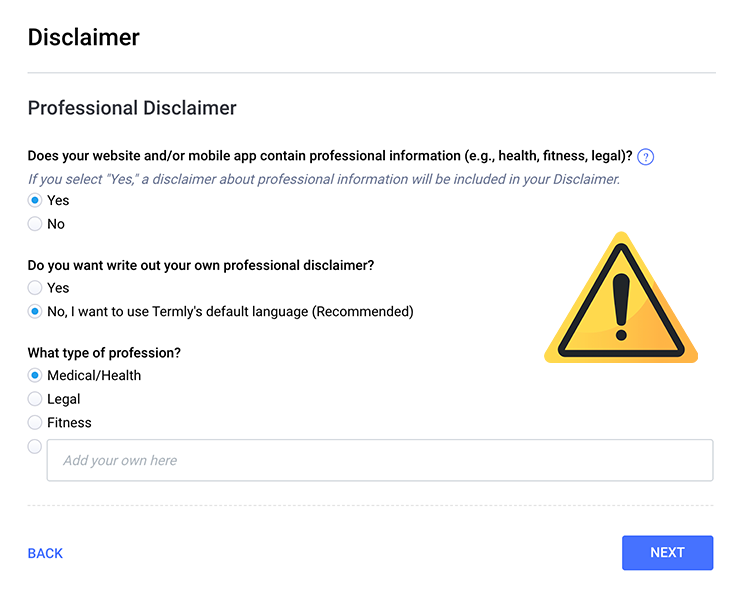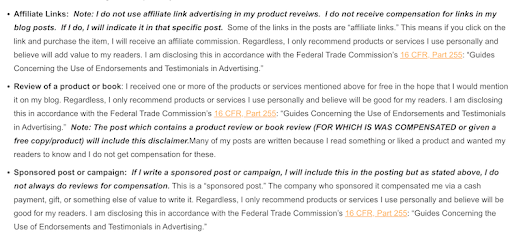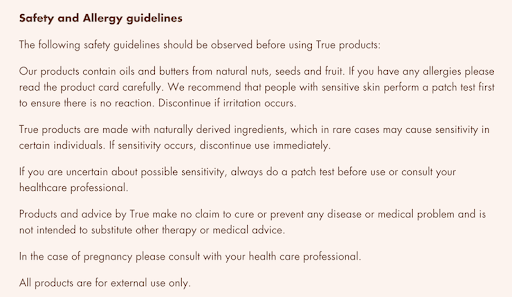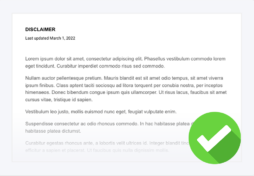If your website sells or reviews products, you can use different product disclaimers to set user expectations and limit legal liabilities — the four most common are:
Below, I explain how product disclaimers work, present some examples, and explain how you can make your own.
How To Make a Product Disclaimer
To create a product disclaimer for your website, use a disclaimer generator or template or write one yourself.
Generate a Free Disclaimer Using Termly
Here’s how to use Termly’s generator to create a comprehensive product disclaimer for your website or app.
Step 1: Go to Termly’s disclaimer generator.
Step 2: Answer a few simple prompts and questions, and go through all the steps until you reach “Final Details.”

Step 3: Once you’ve completed everything and are satisfied with the preview, click “Publish.”
You will then be prompted to create an account on Termly to save and edit your legal disclaimer further.
Template
You can also use our free disclaimer template and customize the blank sections to make a product disclaimer for your website.
The formatting is already completed for you; just include the unique details about your business as necessary.
You can then choose how to download and easily add it to your website.
Do-It-Yourself
You can also write your own product disclaimer — here’s a basic four-step list you can use to help simplify this process:
Once you’re done writing, place your product disclaimer prominently on your site so users can easily locate it.
Consider having a dedicated disclaimer page on your ecommerce websites linked in the footer, header, or main menu so visitors can always access it.
What Is a Product Disclaimer?
A product disclaimer is a statement used by sellers, marketers, and manufacturers to let consumers know what to expect from their products or product reviews.
Product disclaimers help companies avoid legal trouble if customers misuse their products and end up with damages/injuries.
There are many types of product disclaimers, but in this guide, I’ll talk about the four most common ones:
- Product Warranty Disclaimers
- Product Review Disclaimers
- Product Description Disclaimers
- Beauty Product Disclaimers
Product Warranty Disclaimer
A product warranty disclaimer explains the warranty status of a product.
Online sellers often offer limited warranties that cover manufacturing defects or failures but do not apply to misuse, abuse, etc.
It’s common for this type of disclaimer to include phrases like “as is” and “express or implied.”
- “As is” language lets customers know they’re getting the product exactly as they see it in the store or on your website. Since customers evaluate the product before buying it, this removes responsibility from the manufacturer and/or seller if it doesn’t work correctly.
- “Express or implied” language protects sellers from any injuries sustained or damages incurred if a customer misuses a product and is injured or damaged, preventing them from suing the manufacturer or seller.
If your business doesn’t offer a warranty, make this known in a product warranty disclaimer.
Or, if you sell items via a third party, you can use this disclaimer to inform customers that you’re not responsible for warranty or warranty-related claims.
Product Review Disclaimer
A product review disclaimer lets website visitors know when compensation was received in exchange for a product review.
If you review products on a website or blog, you need a product review disclaimer, also called an affiliate disclosure, posted near the sponsored content.
It should follow all consumer protection laws that apply to your business.
Product Description Disclaimer
A product description disclaimer lets users know that the descriptions for products listed on a website are either:
- Provided by the manufacturer
- Not guaranteed or promised
- Subject to change
- May be incorrect or inaccurate
Using a disclaimer like this protects sellers from liability in case of manufacturing defects or inaccurate product specifications.
Beauty Product Disclaimer
Beauty product disclaimers usually describe the product’s ingredients, provide proper usage instructions, and warn consumers about potential allergic reactions.
Sellers can also use beauty product disclaimers to state that the product cannot be used to diagnose or treat actual medical conditions.
Since many beauty products deliver varying results, they usually have a disclaimer stating their claims are based on valid research, but the results may vary.
Do I Need a Product Disclaimer?
Businesses need product disclaimers for three main reasons:
Product Disclaimer Examples
In the next section, I’ll walk you through some good examples of product disclaimers to help inspire you when you go to make your own.
Product Warranty Disclaimer
To start, let’s look at a sample of a product disclaimer that focuses on warranties from Ashop, a British ecommerce and shopping cart software provider.
As shown in the screenshot below, Ashop presents consumers with a comprehensive warranty disclaimer that uses mindful wording to explain they do not offer warranties.

Ashop’s warranty disclaimer includes both critical phrases mentioned previously: “as is” and “express or implied.”
The language used in a warranty disclaimer is important.
Improper wording can make companies vulnerable to lawsuits, so be mindful when making one for your website.
Product Review Disclaimer
Next, for a good example of a product review disclaimer, let’s look at one from AIW² Branding and Design.
As shown below, their product disclaimer is detailed and covers multiple aspects of their services.

Their disclaimer is ideal for disclosing any compensation or affiliation to the supplier of the reviewed products.
It’s concise and builds trust with the readers by adding links to the exact section of the FTC’s guidelines, which isn’t required but does show readers they know what they’re talking about.
Product Description Disclaimer
Next, let’s look at a product description disclaimer sample from 3M that lets buyers know that they are solely responsible for evaluating and buying products.
As shown in the screenshot below, their disclaimer is thorough and uses vital language to remove liabilities from their plates, just in case a product description on their site is wrong.

Detailed product description disclaimers are essential for sellers and marketers in niches where minor inconsistencies in descriptions can have significant consequences, like electronic, industrial, or healthcare products.
Avoid any legal liabilities that arise from customers’ understanding of product descriptions by using a legal disclaimer for products.
Beauty Product Disclaimer
Finally, let’s look at an example of a product disclaimer from True Mindful Beauty, a store that sells cleansing oils, face masks, and other items.
Their beauty product disclaimer is ideal because it’s split into two easy-to-digest parts, with one-line sentences highlighting allergy and safety guidelines.
As shown in the screenshot below, their disclaimer is easy for consumers to read and understand.

Beauty product disclaimers mainly focus on listing primary ingredients that could lead to allergic reactions, elements some consumers might be sensitive to, and instructions for pregnant women.
If you use one of these, make sure yours is just as thorough as the example above.
Where To Put a Product Disclaimer
After you’ve made your product disclaimers, you should post them in the following places throughout your website to ensure consumers can find and read them:
- Within your terms and conditions agreement: This is a great place to house a disclaimer because it ensures users always know where to find them.
- In a dedicated disclaimer page: If you require many disclaimers or if your disclaimers are extra vital, put them on a dedicated page on your site and link it to the footer so users always have access to them.
- On relevant product pages: It makes sense to add a product disclaimer directly to relevant product pages so users are properly informed before making a purchase.
Summary
Product disclaimers are essential for websites that sell goods online, as they help remove liabilities from your plate and keep your consumers properly informed.
Depending on your industry, you should consider adding some or all of the following essential product disclaimers to your website:
- Product Warranty Disclaimers: This section informs consumers about any warranty guidelines or restrictions, including whether they’re honored by third parties.
- Product Review Disclaimers: If you post reviews on your website, this will inform consumers that you cannot be held accountable for what others say about your products.
- Product Description Disclaimers: This statement informs people that your company is not accountable for inconsistencies or errors in any product descriptions on your website.
- Beauty Product Disclaimers: This statement informs people if your products contain common allergens or ingredients they are often sensitive to and provides instructions for proper use.
You can easily make product disclaimers for your site in minutes using our free Disclaimer Template or Disclaimer Generator.


